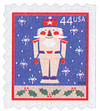
# 4432 - 2009 44c Contemporary Christmas: Toy Soldier, ATM booklet
Winter Holidays – Nutcracker
2009 Contemporary Christmas
ATM Stamp
Issue Date: October 8, 2009
City: New York, NY
Toy Soldiers have long been a favorite way for children to pass the winter days. These popular toys figure prominently in E.T.A. Hoffman’s book, The Nutcracker and the Mouse King, which later became the holiday classic
The Nutcracker. Hoffman’s story features an imaginative girl named Marie (Clara in the ballet) and her brother Fritz. Marie is delighted with the gift of a nutcracker soldier. On Christmas Eve, the nutcracker comes to life and leads Fritz’s toy soldiers into battle to defend Marie from the evil Mouse King and his mouse army.
Another famous story involving toy soldiers is Babes in Toyland, an operetta (short, light-hearted musical theater) composed by Victor Herbert. It was a big Broadway success in 1903, and later became a favorite holiday season movie starring the comic team of Laurel and Hardy in 1934. The operetta features an army of toy soldiers that defeat an evil toymaker. The productions have also been called “March of the Wooden Soldiers,” and “March of the Toys.”
Toy soldiers were often painted, hand-carved wood, but have also been made of metal, with lead being the most common. Plastic soldiers have flourished in the last few decades. Toy soldiers – wood, metal, and plastic – are still treasured by children.
Winter Holidays – Nutcracker
2009 Contemporary Christmas
ATM Stamp
Issue Date: October 8, 2009
City: New York, NY
Toy Soldiers have long been a favorite way for children to pass the winter days. These popular toys figure prominently in E.T.A. Hoffman’s book, The Nutcracker and the Mouse King, which later became the holiday classic
The Nutcracker. Hoffman’s story features an imaginative girl named Marie (Clara in the ballet) and her brother Fritz. Marie is delighted with the gift of a nutcracker soldier. On Christmas Eve, the nutcracker comes to life and leads Fritz’s toy soldiers into battle to defend Marie from the evil Mouse King and his mouse army.
Another famous story involving toy soldiers is Babes in Toyland, an operetta (short, light-hearted musical theater) composed by Victor Herbert. It was a big Broadway success in 1903, and later became a favorite holiday season movie starring the comic team of Laurel and Hardy in 1934. The operetta features an army of toy soldiers that defeat an evil toymaker. The productions have also been called “March of the Wooden Soldiers,” and “March of the Toys.”
Toy soldiers were often painted, hand-carved wood, but have also been made of metal, with lead being the most common. Plastic soldiers have flourished in the last few decades. Toy soldiers – wood, metal, and plastic – are still treasured by children.








